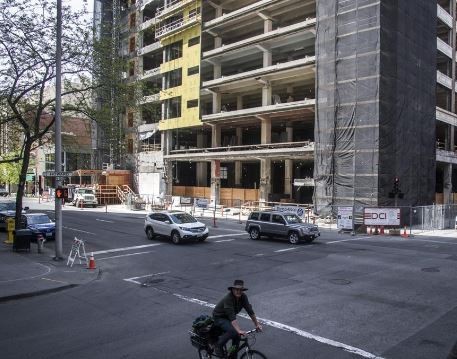Construction spending most in a decade across Spokane
Sunday, January 27, 2019

(as reported in The Spokesman-Review by Nicholas Deshais)
Spokane wasn’t built in a day, but it definitely boomed in the last year.
With $880.5 million in new construction in 2018, Spokane grew more than any year since 2007, when new construction totaled more than $1 billion.
Before fingers point to the Amazon fulfillment center rising on the West Plains, that massive project didn’t count toward Spokane’s dollar figure in new construction for the appraisal year of 2018, which officially ended July 31.
“It didn’t really play a role,” said Byron Hodgson, chief deputy assessor with Spokane County. “The new construction amount, we haven’t reached that in a long time. It is a significant number. It’s a lot of activity.”
The 2.5-million square foot, $181 million Amazon warehouse is on deck to be counted in 2019. As is Larry Stone’s $60 million high-rise project at the old YWCA site, and Avista’s $50 million Catalyst project in Spokane’s University District.
What did drive the new construction tally – which pushed it above the 2017 total of $689 million – were other familiar big ticket projects: the $65 million renovation of the former downtown Macy’s building into apartments, the $35 million Katerra factory in Spokane Valley and the $15.6 million Costco built on North Newport Highway.
The M is owned and was developed by the Cowles Co., which also owns The Spokesman-Review. The 52 acres of land Katerra is building on was purchased for $5.3 million from Centennial Properties, which is also owned by the Cowles Co.
The construction boom has fueled an increase in the county’s value, which stands at $49.7 billion. Hodgson said he’s batted away claims that the county’s valuation and construction figures are attributable to inflation.
“It’s not inflation. It’s a lot of new actual construction. It’s a real number,” Hodgson said. “Inflation’s been very low and very stable. This is an actual real amount.”
In other words, your house gaining value just by sitting there didn’t add to this number, even if you did finally add that extra bathroom. Remodels do count as new construction, Hodgson said, but most of the rise comes from new buildings going up.
Besides being the best year for construction since 2007, it’s far above the low point in that 12-year span. In 2011, there was $282.7 million in new construction in the county, a number that has generally crept up each year since.
Another big number that Spokane hasn’t seen in a while is the amount of parcels that had to be inspected for construction. County appraisers had to physically inspect 9,263 parcels for new construction – up from 8,975 in 2017 and way up from the 2015 total of 4,717 parcels inspected.
For 2018, that equated to more than 25 inspections a day for a staff of 22 field inspectors – 15 residential appraisers and seven commercial appraisers.
Each project must be measured, photographed, sketched and entered into the county’s appraisal software.
“It’s time-consuming. If it’s a commercial building, it may take several days,” Hodgson said. “If it’s a simple residential property, maybe not so much, but residential properties are a lot more complex than they were 20 years ago.”
Seeing the increased amount of work resulting from the construction, the assessor’s office recently made a successful appeal to the county commissioners to hire two new appraisers.
Besides the number of inspections appraisers must do, the size and scope of the county is a hurdle. At 1,781 square miles, it has 210,000 parcels of land and more than 139,000 single-family residences and duplexes. Making matters more complex for the assessor’s office, the county has 55 taxing districts within its borders, which create 124 tax areas due to overlapping boundaries of school districts, fire districts, library districts, cities and towns.
“You look at the size of the county,” Hodgson said. “The county is everything. All the municipalities. All the industrial property. It’s the parcel count from east to west, north to south.”
The size of the county won’t change anytime soon. Its value, however, is another story.